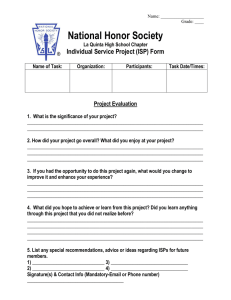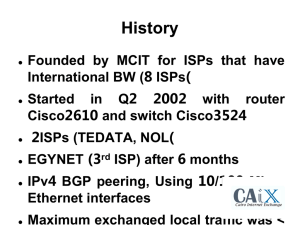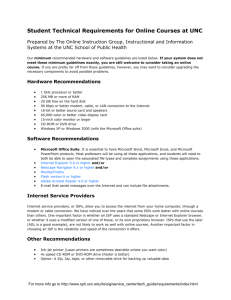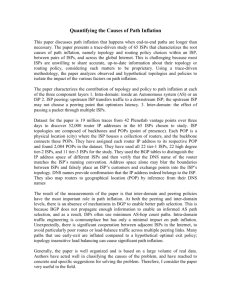End-to-end Quality of Service Robert Rudin, Chaki Ng, Clifford Kahn 5/16/2006
advertisement
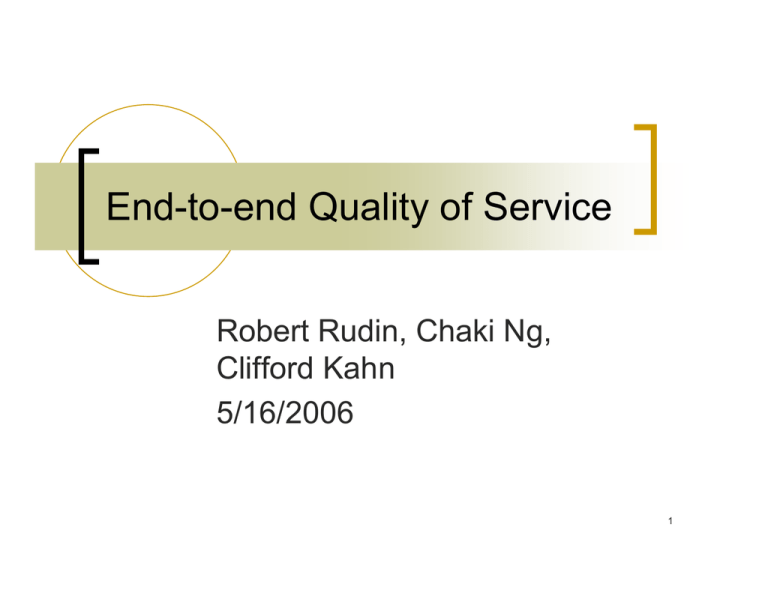
End-to-end Quality of Service
Robert Rudin, Chaki Ng,
Clifford Kahn
5/16/2006
1
Conclusions
Major barrier to service-level
interconnection is coordination
Need a coordinator – an overlay
Network Neutrality: justified
Government could lead the way
2
Three Levels of
Interconnection
3
Structure of Talk
Narrowing the problem: video
conferencing
The stakes
How stakeholders may solve the
problem
Government’s role
4
High Quality Video Conferencing
May Help Drive QoS
Widespread VC foreseeable
Needs considerable bandwidth
{
Could press existing network capacity
HQVC has a money flow that helps
answer “Who pays for the QoS”?
QoS = Lack of jitter, lack of loss, low
latency
5
Non-Internet Video
Conferencing
Multi-billion dollar industry
Hard-wired conference rooms
Private IP network or ISDN
Dependable; good video quality
Monthly costs are US$ thousands
But can’t conference with everyone
you want
6
Internet-Based Video
Conferencing
WebEx, Skype, NetMeeting
Connect from anywhere
{
Another company, a laptop on the road
Much cheaper
But undependable
7
Needed: Best of Both
Widely available
{
Over the Internet
High-quality & dependable
{
Quality of HDTV
8
Interconnection Is Lacking
There is no good QoS across ISP
boundaries
It is not a technical problem
It is a problem of coordination of ISPs
9
Stakeholders’ Interests
Customer
Cannot sacrifice reliability, security
{
Access ISP
Offering profitable HQVC-related services
{
{
Vertical integration
Offering HQVC to many points
Backbone ISP
{
Profiting from carrying high-QoS traffic
10
Stakeholders’ Interests (2)
Application Provider
{
{
Profit
Having QoS among many points
Regulator
{
Avoiding inefficiencies we will discuss
11
Possible Scenarios
ISPs self-organize
App providers deal individually with
ISPs
Overlay coordinates
12
ISPs self-organize
Currently unorganized
{
{
{
No industry-wide
agreement on QoS
No standards /
coordination initiatives
Money is left on table
Need lots of
arrangements
{
Each ISP negotiates
with all/most of its
neighbors
ISP
ISP
ISP
ISP
ISP
ISP
Business Arrangements
13
ISPs self-organize (cont'd)
Complex task to coordinate
{
Unclear compensation schemes
{
Pay by quantity? Pay by congestion?
Conflicting internal policies to optimize
End-to-end QoS unlikely
{
{
More than agreeing to a standard –
manage complex money flows
Possible fragmentation
14
App Providers Deal with ISPs
ISP
High incentives
{
“Face” to the customers
{
Takes blame if low quality
No need to contact ISP for
separate QoS
AP
ISP
ISP
AP
Possible strategic edge
Better service than
competition
Co-market “bundles” with
selected access ISPs
ISP
ISP
AP
15
App Providers: Packet Flow
16
App Providers: Money Flow
17
App Providers: Issues
Still very high costs to coordinate
{
App providers want exclusivity
{
Fragmentation possible
Small app providers may be left out
{
Critical to partner with large ISPs
High costs, no bulk discounts by ISPs
Doubtful many app providers can
coordinate a majority of ISPs
18
Reality Check
Getting ISPs to self-organize is hard
Getting App Providers to each organize
with every ISP is hard
Potential role for an overlay as a
coordinator
19
Overlay Drives Coordination
Trusted 3rd party
Overlay manages:
{ money flow
{ traffic through
preferred ISPs
Who pays whom:
{ Users pay APs
{ APs pay overlay
{ Overlay pays
ISPs
ISP
AP
ISP
ISP
Overlay
AP
ISP
AP
ISP
Business Arrangements
20
Case Study - Internap
Lease bandwidth from backbone ISPs
Provide very high dependability by
avoiding ISPs with congestion
21
Internap Congestion Routing
But Internap doesn't offer last-mile QoS
22
Overlay Benefits
For ISPs:
{
{
Can remain a “cloud” to other ISPs
Coordinate with one overlay
For App Providers:
{
{
Lower cost than self-organizing
Large/small providers can get SLA
Deal only with overlay – no ISP
For consumers:
{
{
Same way to sign up / get service
Extra fees, if any, paid only to app provider
Widely availability - can reach more users
23
{
Summary of Scenarios
# of
Coordinations
ISPs
App Providers
Overlay
# ISPs * #
Neighbors
# ISPs * # Aps # ISPs + # Aps
Fragmentation Medium
High
Low
Trade Secret
Sensitivity
High
Medium
Medium
Scalability for
New Aps
High
Low
High
24
Overlay: A Natural Monopoly?
High sunk cost: putting a system of
coordination in place
Low marginal cost: operating, adding
new ISPs
Network externalities; hard to start up
But after it is done once, others may
learn from example
25
Network Neutrality
QoS is new revenue opportunity for
ISPs
If monopoly, overlay should be neutral
for QoS traffic
{
More enforceable
26
Network Neutrality (cont’d)
New problem: pro-QoS discrimination
{
{
ISPs degrade non-QoS traffic on purpose
Requires regulation?
27
Government Initiates Overlay
Establish functional guidelines for
overlay
Oversee development of overlay
Provide seed money
28
Conclusions
Major barrier to service-level
interconnection is coordination
Need a coordinator – an overlay
Network Neutrality: justified
Government could lead the way
29
Overlay Definition
(Clark et. al. 2005)
An Overlay is a set of servers deployed
across the Internet that:
a) provide some sort of infrastructure to one (or ideally
several) applications,
b) in some way take responsibility for the forwarding and
handling of application data in ways that are different from
or in competition with what is part of the basic Internet,
c) are operated in an organized and coherent way by third
parties (which may include collections of end-users) to
provide a well-understood service that is infrastructurelike, but,
d) are not thought of as part of the basic Internet.
30
